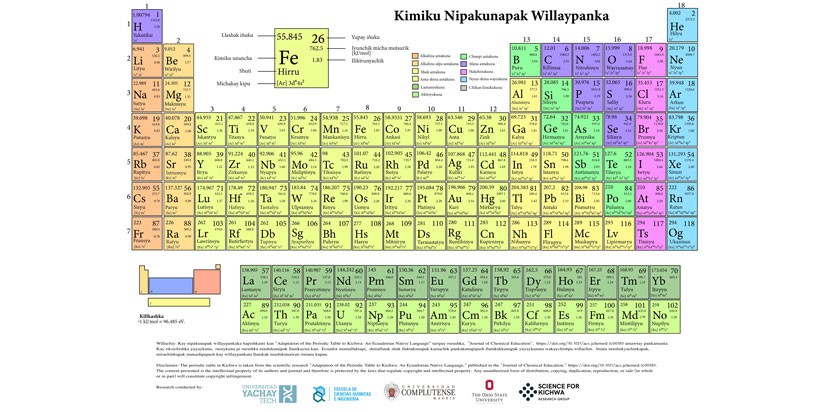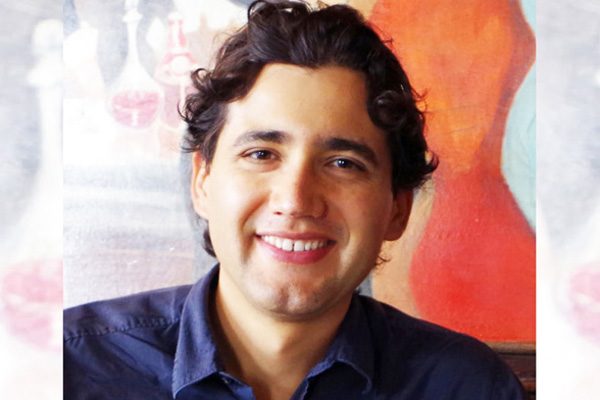
Downloads:
The periodic table is considered the bedrock of chemistry education. Students use it to look up values such as an element’s atomic mass, and it serves as a visual reference for the trends in physical properties. But what use is it if a student can’t read it?
In many ways, the periodic table is a universal language. The symbols, the arrangement of the elements into rows and columns, the data for each element are bits of information that have meaning regardless of what language a student may speak. But the names of the elements are a different story.
The International Union of Pure and Applied Chemistry created official names for chemical elements, relying heavily on the English language. So, the official name for the element with atomic number 8 is oxygen and the name for 29 is copper.
The official names are used in international publications, but it’s still common to see researchers using names accepted in their home countries.
Of course, everyone grows up knowing the names of at least a few chemical elements. Some elements have been known in their pure, uncombined, or elemental form for thousands of years. Gold, silver, and sulfur are very stable and can exist in recognizable forms all over the world.
Over the past 200 years many more elements were identified ed and most of them entered the common vocabulary of each language. For example, copper is known as cuivre in French, Kupfer in German, rame in Italian, tóng in Chinese, and cobre in Spanish.
The element known as iron in English is fer in French, Eisen in German, ferro in Italian, cheol in Korean, and hierro in Spanish. For elements discovered more recently, the names in various languages are much more similar. For example, technetium is known as technetium in French, Technetium in German, tecnecio in Spanish, and tekunechiumu in Japanese.
Periodic tables that include the names of the elements and titles for the data in native languages are very common. It’s easy to find examples of tables that were translated into various foreign languages. A quick search turned up nearly 100 versions in various language, including Spanish, French, Portuguese, Swahili, Japanese, Chinese, Croatian, and even one in Klingon.
While that is a lot, it is important to keep in mind there are some 6,000 languages spoken in the world, and not having access to science information in indigenous languages can be a major problem for native speakers who want to advance in their education.
In one instance, researchers solved that problem for people who speak Kichwa, a language used by about half-a-million people in parts of Ecuador, Colombia, and Peru. The Kimiku Nipa-kunapak Willaypanka (periodic table of chemical elements) presents Kichwa words for all 118 elements and other terms, such as atomic weight.
The researchers say the adapted periodic table will help Kichwa speakers learn science. At the same time, having Kichwa words for elements could help Kichwa speakers communicate local knowledge of, say, medicinal plants to non-Kichwa speakers.
The researchers started their adaptation by translating element names into Kichwa in different ways. For some elements, such as helium, the team used the element’s etymology to make a new Kichwa word.
Helium comes from the Greek word for the sun, so they proposed “intiku,” from the Kichwa words inti (the sun) and ku (belongs to). For other elements, they transliterated the sound of the English word into Kichwa, so nickel became “nikil.”
The group then used an online survey to ask approximately 150 Kichwa speakers whether they approved of the group’s element names and periodic table terms. In some cases, the survey asked respondents to rank different possible adaptations of element names.
The researchers noted that many of the respondents preferred names that sounded similar to the words for the elements in Spanish, the language most widely spoken in Ecuador. This was especially true in the case of a particular sound that doesn’t exist in Kichwa, such as for several elements with an “f” sound. For fluorine, they settled on flur for Kichwa, which is similar to flúor in Spanish.
Translations into indigenous languages are important for people to feel included in the process of science, it helps to be able to understand science in their own language, because a language carries with it the values and traditions of a culture.
But indigenous speakers will likely need to learn one of the major languages to be successful at higher levels of education. Where is the balance among various languages? That is open for discussion.
This article was adapted from “Adapting the Periodic Table into Kichwa. A Team Including Native Speakers Created a Periodic Table in an Indigenous South American Language,” which was originally published in Chemical & Engineering News on November 16, 2021.








